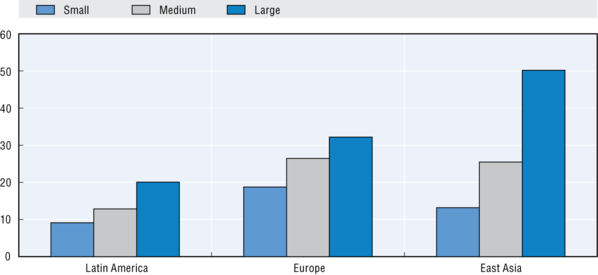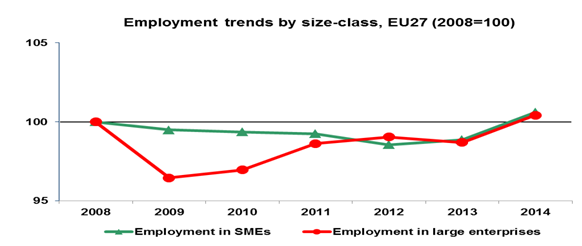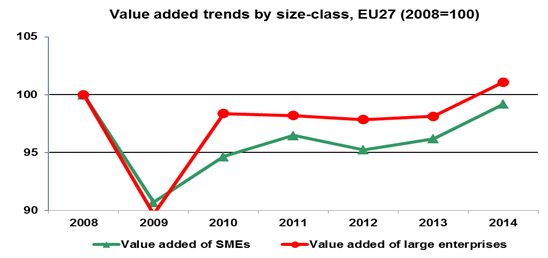-
Paper Information
- Paper Submission
-
Journal Information
- About This Journal
- Editorial Board
- Current Issue
- Archive
- Author Guidelines
- Contact Us
International Journal of Internet of Things
2014; 3(1): 1-7
doi:10.5923/j.ijit.20140301.01
Matters Arising from SMEs E-Commerce Adoption: Global Perspective
Cudjoe Dan
School of Economics and Management, Beijing University of Technology, Beijing, 100124, P.R. China
Correspondence to: Cudjoe Dan, School of Economics and Management, Beijing University of Technology, Beijing, 100124, P.R. China.
| Email: |  |
Copyright © 2014 Scientific & Academic Publishing. All Rights Reserved.
The adoption and use of e-commerce by SMEs have yielded many positive results. Besides the many success SMEs have enjoyed from adoption of e-commerce, there are some problems and challenges that hinders the growth of adoption of e-commerce by SMEs around the globe. As some SMEs are making good use of e-commerce to expand their businesses to the global market and increasing sales as well as profits, others have been very slow in adopting e-commerce. Most especially in Africa and other developing countries, SMEs have lower patronage in e-commerce adoption. Therefore, the purpose of this paper is to review e-commerce adoption factors in SMEs. The paper further discusses definition of SME by some countries. In addition, SMEs readiness for e-commerce, Impact of globalization on SMEs e-commerce adoption, and potential benefits of e-commerce for SMEs are discussed in this paper.
Keywords: Globalization, Potential, Patronage, E-commerce
Cite this paper: Cudjoe Dan, Matters Arising from SMEs E-Commerce Adoption: Global Perspective, International Journal of Internet of Things, Vol. 3 No. 1, 2014, pp. 1-7. doi: 10.5923/j.ijit.20140301.01.
Article Outline
1. Introduction
- Adoption of electronic commerce offers a great opportunity to SMEs to gain greater global access and reduce transaction costs, provides substantial benefits through improved efficiencies and raised revenues; facilitates access to potential customers and suppliers, productivity improvements, customization of products and services and information exchange and management. [26]With rapidly growing, small business needs and changing business environment there is the need to imply internet, especially for SMEs who want to grow their business and compete in market. Since the emergence of the internet it has allowed SMEs to compete efficiently and effectively in both domestic and international market. E-commerce has provided a tremendous amount of benefits to SMEs, as e-commerce continues to evolve it has provided a number of research opportunity for Information System community. [9] E-commerce not only benefits well developed business to increase their product and vision but also aid SMEs to reach their targeted goals.Due to the global reach of e-commerce, Small and Medium-sized Enterprises in the developed countries have started adopting e-commerce in their business; but SMEs in Malaysia and many other developing countries are still reluctant to use Information Technology (IT) or e-commerce in their day-to-day business operations. According to Statistics Small and Medium Scale Industries (SMI) Association of Malaysia, Only 30% of the SMEs in Malaysia have a web presence and use IT on their daily basis. [23] Despite its importance, prior studies indicated that electronic commerce usage is more pervasive among large firms than SMEs. Furthermore, many researchers suggest that electronic commerce benefits to the SMEs are not par with large firms. This is partly due to the fact that SMEs generally have limited resources and technology capabilities. [25] Despite the resources constraints, Al-Qirim argues that the less complicated structure of smaller firms make them more flexible to adapt to changes, hence easier to fit with the electronic commerce application. [1]Issues of electronic commerce in SMEs need to be given the maximum attention since it plays vital role in the nation’s building as they always represent the largest proportion of established businesses in most countries. In addition, ICT is one of the important means to facilitate SMEs business operations. Consequently, it is an appropriate time for SMEs to consider internet and electronic commerce. Deploying IT enables firms to quickly respond to the environmental pressure, fulfill customers demand, and embrace globalization. [4] However, this article will be looking into matters that arise from SMEs e-commerce adoption from the global point of view which includes; definition of SME by various countries, SMEs readiness for e-commerce adoption, impact of globalization on SMEs e-commerce adoption, potential benefits of e-commerce for SMEs, and the paper will finally review e-commerce adoption factors in SMEs.
2. SME: An Overview
- Small and Medium-size Enterprise is represented by the abbreviation SME.However, what exactly SME is depends on who’s doing the definition. Industry Canada uses the term SME to refer to business with fewer than 500 employees. [11] Business segment term used differently in different countries, sometimes differently in different industries in the same countries. In the USA, any firm from a small-office home-office (SOHO) to a large corporation maybe called a SME. More especially, firms included in Russell indexes such as Russell 2500 index and Russell Midcap index are classified as SMEs. In European Union, a firm with 50 to 250 employees, annual turnover of 7 to 40 million Euros, total assets less than 27millon Euros and more than 25% ownership by a large corporation, maybe classified as a SME. The International Chamber of Commerce (ICC) defines SME as having 100 to 2000 employees. [14] The table below throws more light of European Commission’s SME definition.
|
2.1. Global Implementation of SME
- Small and Medium-sized Enterprises (SMEs) are very heterogeneous group. SMEs are found in a wide array of business activities, ranging from the single artisan producing agricultural implements for the village market, the coffee shop at the corner, the internet café in a small town to a small sophisticated engineering or software firm selling in overseas markets and a medium-sized automotive parts manufacturer selling to multinational automakers in the domestic and foreign markets. [29] SME comprises the overwhelming majority of firms in almost all countries, and contributes to at least two thirds of total employment. [30]Latin American SMEs generally have a hard time entering the trade and production streams that characterize the globalized economy and most of them participate in local or national, rather than supranational, productions systems. This is due to the nature of goods they produce and the type of market they serve. SMEs in Latin America are less internationalized than those in other regions. According to World Bank data, direct and indirect exports levels of Latin American SMEs are only half of those recorded in Europe and are one-third less than those seen in four East Asian countries. [31] The figure below gives details.
 | Figure 1. Enterprises that export directly or indirectly by size and region, 2009-10 (source: reference 31) |
 | Source: reference 33 |
 | Source: reference 33 |
3. SMEs Readiness for E-commerce
- For SMEs to be able to adopt a successful and convenient e-commerce, an SME must acquire the necessary infrastructure needed to be able to have a smooth adoption of e-commerce. SMEs need ICT infrastructure such as laptop, Smartphone, personal computers, and any other devices; also they must be connected to the internet or other communication network.An essential element would be power to run any of this electronic equipment, which is easily available in developed nations but may not be so for many SMEs in rural areas of the developing world. In a comparative study among SMEs in USA, Spain, Portugal and Poland found that a nation’s ICT readiness greatly assists its SMEs to apply more knowledge-based ICT in their businesses. [2] E-commerce application includes the use of many different types of online facilities to do business: order registration, electronic advertising, electronic billing system, electronic marketing, online delivery status and tracking and customer service support. [27] Therefore, it’s vital for SMEs to equip themselves with the needed online facilities before adopting e-commerce in order to fit into today’s e-commerce business.Survey responses on perceived obstacles indicate that numerous SMEs fail to exploit the opportunities of e-commerce because of their lack of awareness of the potential benefits. SES Canada Research Inc. reported that for SMEs not yet using the internet, the main obstacles preventing the adoption of electronic commerce are indifference and disinterest. Compared to large firms, the inability to correctly assess the impact and benefits of electronic commerce makes SMEs more cautious about the investment and cultural change involved. [22] Besides the weakness on the part of some SMEs to adopt e-commerce, some SMEs especially in the developed countries have been able to adopt e-commerce successfully. Others (in the developing countries) are also making progress as internet usage become very famous in the 21st century.E-commerce company and internet service provider Africa online has struck partnerships with a number of universities to offer courses on e-commerce and capacity building among SMEs in African countries like Kenya. Countries where SMEs are tapping into their Diasporas networks for e-commerce include Cuba (for remittance of foreign exchange) and Ethiopia (for online gift services). Small and Medium-sized tourism operators in Thailand are successfully using web sites and e-mail for booking orders, especially among repeated visitors. [13]
4. Impact of Globalization on SMEs E-commerce Adoption
- Globalization describes a situation whereby national and regional economies, societies, and cultures have become integrated through the global network of trade, communication, and transport.Globalization and the dynamic development in ICT, especially the internet and other computer mediated networks have been cited as some of the drivers of e-commerce adoption. These drivers have had impact on SMEs differently depending on the nature, characteristics, and geographic location of the organization. [20] Globalization can have impacts on SMEs and entrepreneurship and can be regarded in many different ways. The impact on SMEs received much attention in international circles in the past few years. Some positive impacts of globalization on SMEs are as follows:Variety of goods; certain countries provide goods which are only or mostly available in their country. Through globalization goods in different countries can be distributed to other countries which do not have specific goods. With this everyone in the world will have equal access to food, medicine etc. [24]Access to markets and customers; the market and customer which are fundamental to enable SMEs to explore offshore markets and achieve economies of scale, increase performance and accelerate growth. Globalized SMEs are consistently found to out-perform non-globalized exporters using a variety of measures of success, including profitability, production, wages, and sales volume. [18]SMEs through globalization can also be exposed to richer resources, both tangible and intangible. Richer resources facilitate more innovations, and growth performance. [15] Globalization of business by SMEs is like ‘fire’ it can be good but also a bad master.There is limited funds to finance invests and initial operating losses for new activates. Spending on market research and market entry take much higher proportion of total spending in SMEs than in large firms. There are also limited numbers of staff to take on additional tasks on the international market.The decision to globalize and enter export market needs a strong vision, commitment and determined leadership of the owners. The people need to be convinced that this is a strategically important step for the business long-term development. Only that they will be able to overcome the numerous risks and problems which accompany globalization of a business. Moreover, going global requires a certain degree of international experience and knowledge with the organization. Without that the business will depend too much on a third person’s advice. Finally, every SME has to understand that global activities do mean more than just finding new customers or suppliers in other countries. The globalization of a business involves a process profound change. This change requires taking risk, opening up the firm’s culture and a great capacity to learn. None of this happens spontaneously but requires planning and clear leadership. Hence, the planning of these international changes should be part of the planning for global activities. [7]
5. Potential Benefits of E-commerce for SMEs
- E-commerce can provide substantial benefits to small enterprises through improved efficiencies and raised revenue. It enables a new way of working to emerge as business face the future and embrace the new economy. [5] E-commerce enables small business entrepreneurs to gain access to better quality information, and thus empowers them to take informed decision in their business. [16] Most importantly, e-commerce can give a competitive advantage. It can help strengthen market position and open up new business opportunities with potential to improve profits. [6] E-commerce provides opportunity for Small and Medium-sized Enterprises (SMEs) to overcome logistical and geographic challenges in terms of access to markets. By selling products online, the need for middlemen disappears, allowing business to reduce transaction costs and become more competitive. [8] E-commerce enables SMEs to conduct better and quicker customer service. In some cases, customers could have direct access to their own personal accounts online and can avoid calling companies on the phone. This can save time and money. Adding customer online services such as overnight package delivery service by package tracking services which allow customers to check the where about of their packages online. This helps to provide good levels of customer satisfaction with very little from the side of the business.Even though e-commerce offers several benefits to SMEs, we must note that nothing good comes easily. Many of the benefits can be gained through relatively modest investments in new technology and systems. However, it is vital to note that the benefits stated above are not tied to e-commerce. For instance, market benefits may be achieved effectively through better business networking than just the use of internet.
6. Reviewing E-commerce Adoption Factors in SMEs
- This section of the paper will review some of the general factors that affect e-commerce adoption in SMEs. The factors will be discussed in the following categories: Individual, organizational, technical and environmental factors.
6.1. Individual Factors
- When we look at the individual factors it includes management of the firm, staff and customers who transact business with the firm. These are the people who are affected largely by the adoption of e-commerce.The education and awareness of the people are considered very vital before, during and after e-commerce implementation. However, it is very good to care more about education and awareness along with IT skills and expertise for organization towards the adoption of e-commerce as implementation of new techniques may change employees work attitude, qualification, performance and knowledge of e-commerce. [10]
6.2. Organizational Factors
- These are the factors that describe the nature and characteristics of the organization, these always make the organization stands out from its fellows. There are several factors that draw back or motivate e-commerce adoption within the boundary of an organization. These factors include: security, trust, privacy concerns, financial ability and cost implications, size of the organization, perceived benefits of ICT, and organizational culture.
6.3. Environmental Factors
- Environmental factors relate to markets, competitive pressure, government rules and regulations, suppliers, vendors, partners and customers. [28] Competitive pressure from other internet adoption within the industry, availability of right partners to work with, readiness of suppliers for electronic business, and viable market or customer base e-commerce are the considered environmental factors.
6.4. Technical Factors
- Technical factors constitute the lack of internet security, lack of e-commerce infrastructure, lack of technical knowhow or qualified staff, inadequate quality and speed line and innovation and new technologies. [3] SMEs perceptions of the technology a role in producing structures of domination. The owners perceive power when they can foresee further advantages (resources) from their environment such as acquiring a competitive in the industry if the technology will enhance the organization’s operations and performance. [21]
7. Future Research
- It would be interesting to investigate the factors that affect SMEs e-commerce adoption in rural and urban areas in developing countries.Certainly further research needs to be conducted on e-commerce patronage among SMEs in developing countries and identify what draws back SMEs patronage in e-commerce among the developing countries.
8. Conclusions
- Small and Medium-sized Enterprises (SMEs) have grown in importance in the global economy during the last couple of decades. Both theoretical and practical economic and business development literature shows the key contributions of SMEs to the development of both national and international growth of economy. The fact is not only measured by the number of SMEs which represents nearly 90% of the total establishment across the world, but also their significant role in creating employment opportunities.Because of the usual lack of necessary financial, legal, and physical infrastructure for e-commerce in the developing countries, the adoption of e-commerce in the developing countries differ significantly from developed countries.The effects of e-commerce on globalization of economic activities have created opportunity as well as threat to the growth of Small and Medium-sized Enterprises (SMEs).
ACKNOWLEDGEMENTS
- I would like to acknowledge Prof. Jingwen Li, dean of School of Economics and Management at Beijing University of Technology for his supervision during writing of this paper. My sincere appreciation goes to Prof. Feng, Management Information Systems (MIS) Lecturer at BJUT. Finally, I would like thank all my friends and classmates at BJUT for their support.
 Abstract
Abstract Reference
Reference Full-Text PDF
Full-Text PDF Full-text HTML
Full-text HTML